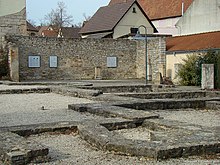Jagsthausen Roman Baths
The Römerbad Jagsthausen is a small open-air museum in Jagsthausen in the district of Heilbronn in Baden-Württemberg , which shows some copies of excavation finds in the reconstructed foundations of a Roman bath .
The cohort fort in Jagsthausen
Around the year 200 AD Jagsthausen was on the Upper Germanic-Rhaetian Limes , the northern border of the Roman Empire . The Roman cohort fort Jagsthausen was located about 400 meters from the Limes, in the area of today's parks of the White Palace and Burg Jagsthausen, as well as the northern town center of Jagsthausen, and a larger civil settlement ( vicus ) was connected to the east, south and west .
Numerous excavated Roman bricks bear the stamp of the 22nd Roman Legion Primigenia Pia Fidelis (LEG XXII P PF) and were probably burned by this legion in Nida near Frankfurt. Goods like those bricks were probably also transported by barges on the Neckar and Jagst . The location of the Jagsthausen fort on Hohen Strasse and the Jagst as a further traffic route could explain its size and importance.
The bath was probably built together with the fort around the year 155 AD and extensively renewed around the year 200 under Emperor Septimius Severus , which is evidenced by a renovation inscription. Although it was a stately size, it was not a matter of magnificent urban thermal baths , but a comparatively simple balineum . According to another inscription, a second, smaller bathroom on site was renovated again in the years 247/49 before the Limes was abandoned about a decade later, whereupon the buildings fell into disrepair.
Excavations and museum preparation
Excavations of the Roman foundations took place in the 19th century, and in 1886 the small bath building with a length of 31 meters was discovered. A Roman urn field with around 200 urn graves was found north of the road to Olnhausen between 1908 and 1913. The large Roman baths had been known since the 19th century, but it was only in the run-up to the construction work planned by the Baden-Württemberg State Monuments Office that it was systematically recorded over a length of around 40 meters for the first time. The foundations that were built over in their further course will probably extend to today's main street, where the main entrance to the facility was probably once located.
Due to the great importance of the find, the planned construction work was not carried out. Instead, the excavations were backfilled as an archaeological reserve and an ideal reconstruction of the bathing facility based on the results of the excavation was then built. With the support of the Würth Foundation , the Kreissparkasse Heilbronn , the Jagsthausen community, the Heilbronn district , the Baden-Württemberg State Monuments Office, the Baden-Württemberg Monument Foundation as well as local associations and traders, the facility was set up as an open-air museum with information boards and copies of Roman Finds are shown, including a veteran stone , altars by beneficiaries , Jupiter altars , a week god stone and others.
Part of a giant column of Jupiter
Monument protection
The floor monument "Römerbad Jagsthausen" is protected as a registered cultural monument within the meaning of the Monument Protection Act of the State of Baden-Württemberg (DSchG) . Investigations and targeted collection of finds are subject to approval, and accidental finds are reported to the monument authorities.
Web links
Individual evidence
- ↑ AE 1995, 1165 .
Coordinates: 49 ° 18 ′ 33 ″ N , 9 ° 28 ′ 12 ″ E





